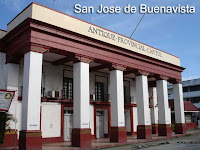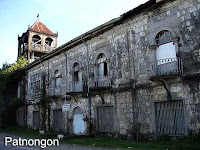For the first time, Iloilo will host the Independence Day celebrations. As part of the 117th anniversary of Philippine Independence, President Benigno Aquino III will lead flag-raising ceremonies at Santa Barbara, Iloilo, where the Philippine flag was first raised outside of Luzon.
This will be followed by the traditional vin d'honneur reception which will be held at the newly-rehabilitated Iloilo Provincial Capitol in Iloilo City.
Iloilo City has become a beacon of hope for local governance, leading the way in sustainable development and heritage conservation. As it makes the drive towards progress, it continues to conserve its rich heritage.
The Iloilo River Promenade is one example of the political will of Iloilo's leaders. They were able to reclaim the river, remove all illegal settlers no matter how influential, replant mangroves, and develop a linear park that has given the community a fantastic public open space. Iloilo Mayor Jed Mabilog has done a fantastic job! Here is a video of the Promenade courtesy of Archt. Paulo Alcazaren who designed the park.
We also got to visit the Iloilo Convention Center which is being rushed in time for the APEC ministerial meetings which the city will host in September. Thank God it isn't the usual generic infrastructure which the government usually churns out. We were toured by Sen. Frank Drilon and former DOT Sec. Narzalina Lim who heads the Iloilo Economic Development Foundation.
Iloilo is a city of parks and plazas. Take note, they don't build barangay halls or covered courts in their plazas. Open spaces are respected. Here is Plaza Libertad as seen from the roofdeck of Iloilo City Hall. And there are fantastic plazas as well in Jaro, Molo and La Paz.
We were treated to a fantastic tabu-an lunch at the Iloilo City Hall! On our table was ginisa nga uhong (kabute with patola), pinindangan (dilis), talaba ukoy, scallops, diwal, Pinoy salad (okra, talong, talbos ng kamote, itlog na maalat, kamatis, sibuyas) with lato paired with fresh Banate bagoong, duck estofado sa tuba at piña, binuro na kasag (alimasag), pork adobo sa achuete, fried ubre (pork mamary gland), prawns, managat and kinilaw na tanigue by Chef Rafael Jardeleza. What a feast!
Speaking of Iloilo City Hall, the old Iloilo City Hall is now part of a campus of the University of the Philippines in the Visayas.
I really love it how Iloilo is giving incentives to heritage building owners to conserve their buildings. The heritage buildings of Calle Real are given fifty percent real estate tax discounts when they rehabilitate their buildings. No wonder Iloilo's heritage is alive and kicking. I wonder when Manila will give incentives to heritage building owners?
Note also that SM is restoring the Lacson-Yusay Mansion (which most call the Consing Mansion) to house a branch of SM Kultura. I wonder when SM will start conserving heritage in other parts of the country, especially in Manila. I hope they continue saving heritage. My fingers are crossed! But at least in Iloilo, they are on the right track.
But what I enjoy most about visits to Iloilo is the food! Oh yes the food! You have to try La Paz Batchoy at the La Paz Market. My personal favorite is Netong's which one can find inside the market.
And of course, there's also Pancit Molo. Ironically, it's difficult to find a restaurant in Molo known for Pansit Molo simply because it's usually prepared as home. Lucky for us, we got to enjoy a hot bowl of Pancit Molo plus Tsokolate Batirol at the Camiña Balay nga Bato (Avanceña Heritage House), Villa de Arevalo, Iloilo City. They get the Pancit Molo from Kapitan Ising.
There are just so many food choices in Iloilo. Here are some of my favorite must-try Ilonggo dishes.
Iloilo has so much to offer. You are missing a lot if you do not visit the original Queen City of the South!
This will be followed by the traditional vin d'honneur reception which will be held at the newly-rehabilitated Iloilo Provincial Capitol in Iloilo City.
Iloilo City has become a beacon of hope for local governance, leading the way in sustainable development and heritage conservation. As it makes the drive towards progress, it continues to conserve its rich heritage.
The Iloilo River Promenade is one example of the political will of Iloilo's leaders. They were able to reclaim the river, remove all illegal settlers no matter how influential, replant mangroves, and develop a linear park that has given the community a fantastic public open space. Iloilo Mayor Jed Mabilog has done a fantastic job! Here is a video of the Promenade courtesy of Archt. Paulo Alcazaren who designed the park.
We also got to visit the Iloilo Convention Center which is being rushed in time for the APEC ministerial meetings which the city will host in September. Thank God it isn't the usual generic infrastructure which the government usually churns out. We were toured by Sen. Frank Drilon and former DOT Sec. Narzalina Lim who heads the Iloilo Economic Development Foundation.
Iloilo is a city of parks and plazas. Take note, they don't build barangay halls or covered courts in their plazas. Open spaces are respected. Here is Plaza Libertad as seen from the roofdeck of Iloilo City Hall. And there are fantastic plazas as well in Jaro, Molo and La Paz.
We were treated to a fantastic tabu-an lunch at the Iloilo City Hall! On our table was ginisa nga uhong (kabute with patola), pinindangan (dilis), talaba ukoy, scallops, diwal, Pinoy salad (okra, talong, talbos ng kamote, itlog na maalat, kamatis, sibuyas) with lato paired with fresh Banate bagoong, duck estofado sa tuba at piña, binuro na kasag (alimasag), pork adobo sa achuete, fried ubre (pork mamary gland), prawns, managat and kinilaw na tanigue by Chef Rafael Jardeleza. What a feast!
Speaking of Iloilo City Hall, the old Iloilo City Hall is now part of a campus of the University of the Philippines in the Visayas.
I really love it how Iloilo is giving incentives to heritage building owners to conserve their buildings. The heritage buildings of Calle Real are given fifty percent real estate tax discounts when they rehabilitate their buildings. No wonder Iloilo's heritage is alive and kicking. I wonder when Manila will give incentives to heritage building owners?
Note also that SM is restoring the Lacson-Yusay Mansion (which most call the Consing Mansion) to house a branch of SM Kultura. I wonder when SM will start conserving heritage in other parts of the country, especially in Manila. I hope they continue saving heritage. My fingers are crossed! But at least in Iloilo, they are on the right track.
But what I enjoy most about visits to Iloilo is the food! Oh yes the food! You have to try La Paz Batchoy at the La Paz Market. My personal favorite is Netong's which one can find inside the market.
And of course, there's also Pancit Molo. Ironically, it's difficult to find a restaurant in Molo known for Pansit Molo simply because it's usually prepared as home. Lucky for us, we got to enjoy a hot bowl of Pancit Molo plus Tsokolate Batirol at the Camiña Balay nga Bato (Avanceña Heritage House), Villa de Arevalo, Iloilo City. They get the Pancit Molo from Kapitan Ising.
There are just so many food choices in Iloilo. Here are some of my favorite must-try Ilonggo dishes.
Iloilo has so much to offer. You are missing a lot if you do not visit the original Queen City of the South!






















































